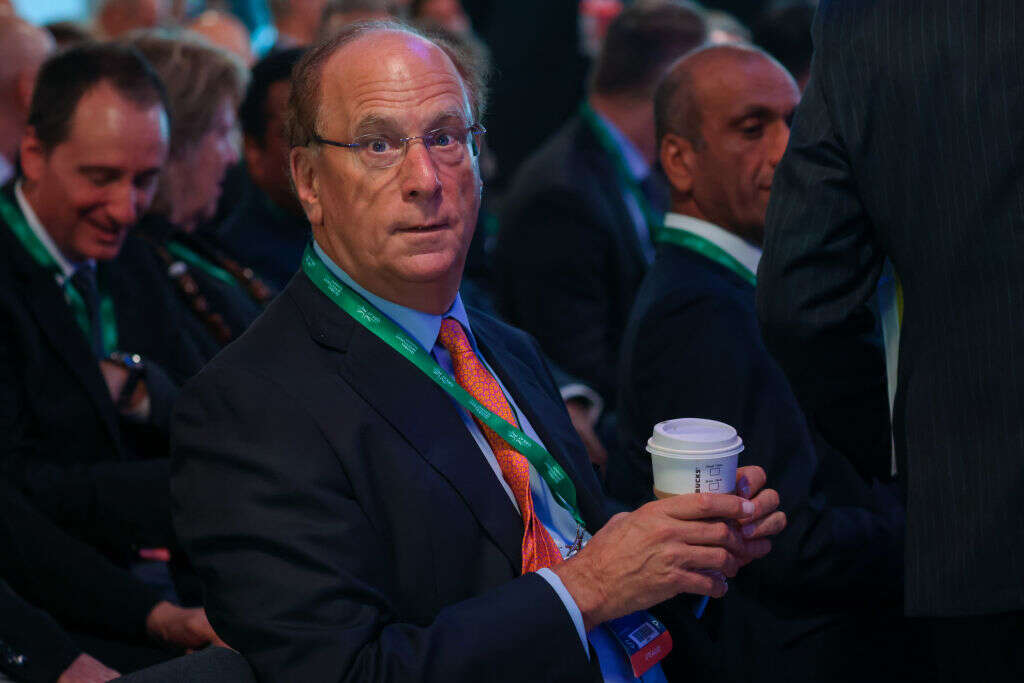

We’re as suprised as you are: Part of BlackRock CEO Larry Fink’s bonus is linked to ESG factors. (Photo by Hollie Adams/Bloomberg via Getty Images)
- Only 11 of the largest 100 asset managers globally incorporated environmental factors into their CEOs’ variable pay.
- Environmental targets for asset manager CEOs tend to focus on stewardship, green product development, ESG screening and ESG ratings.
- European banks and asset managers have been quicker to implement ESG bonus targets than their peers in North America and Asia-Pacific.
Banks are proving keener than asset managers to incorporate ESG targets into the bonus pay of their chief executives, according to exclusive Capital Monitor research.
The report, ‘Linking CEO Remuneration to ESG Targets: The Top 100 Asset Managers’, is based on data provided by Capital Monitor sister company GlobalData. It shows that, globally, only 11 of the largest 100 asset managers, measured by assets under management (AUM), link their CEO’s bonus to environmental factors, compared with 25 of the top 100 banks.
The Fink effect
Fund managers such BlackRock ($9.4trn AUM) fit into the 11%. Half of CEO Lawrence Fink’s $28m bonus for 2020 was down to non-financial indicators. Not all would come under the ESG banner, but some that did include the company publishing its Sustainability Accounting Standards Board (SASB) and Task Force for Climate-related Financial Disclosures (TCFD) reports, sustainable fund development, as well as its diversity hiring drive.
Valérie Baudson, appointed last year at the helm of Amundi ($1.8trn AUM), Europe’s largest asset manager, will have the opportunity to earn a more modest €2m in variable pay, 30% of which will be tied to non-financial indicators. This includes implementing Amundi’s ESG policy, which to date has covered the integration of ESG screening across its actively managed funds and the growth of AUM for specific initiatives such as energy transition.
Some asset managers paid attention to ratings. With $1.8trn of AUM, Legal and General Investment Management’s (LGIM) appraisal of CEO Michelle Scrimgeour noted the company’s A+ UN Principles for Responsible Investment (PRI) rating. PRI ratings are based on ESG integration to overall investment practices, not just on ESG-labelled products, and consider the scope and sophistication of ESG integration.
Invesco ($1.6trn AUM) and Anima Holding ($217bn AUM) also used their PRI ratings in their remuneration decision, while DWS Group ($962bn AUM) used its PRI and CDP (the non-profit formerly known as the Carbon Disclosure Project) ratings. Affiliated Managers Group (AMG, $738bn AUM) referred to its rating from CDP, and Generali Group ($559 AUM) used MSCI and S&P ratings.
The CEOs of LGIM, DWS and AMG were rewarded for advancing their firms’ stewardship of portfolio companies, while Schroders ($938bn AUM) and Generali had targets for integrating ESG processes across their fund range.
Banks vs Asset managers
Banks tended to have a slightly different set of CEO ESG bonus targets, with a focus on sustainable finance volumes, emissions from offices and business travel, and ESG ratings. Both sets of institutions tended not to look at the impact of ESG initiatives. The success of ESG-labelled funds or of stewardship programmes tends to be measured in volumes of AUM or number of votes, rather than the impact of the investment or impact of voting.
It was a similar story for banks with regard to sustainable finance volumes, with the focus largely on volumes rather than impact. Two banking groups, ING and NatWest, had bonus targets that incorporated how their institutions were influencing clients. This was more common in asset management, where stewardship is beginning to form a core part of ESG policies.
ESG target setting was less common among asset managers in the US, which account for 59% of the total AUM of the top 100 asset managers. Of the 52 North American asset managers in the top 100, just four had an environmental remuneration target for their CEO. That was the case for seven out of 34 European asset managers. None of the 13 asset managers in Asia-Pacific had environmental remuneration targets. Europe also led in the number of banks with CEO targets, with 21, compared with one for North America and three for Asia-Pacific.
Neither State Street Global Advisors ($3.9trn AUM) or JP Morgan Asset Management ($4trn AUM), both in the top ten asset managers by AUM, had environmental targets, but did have social and governance targets related to gender diversity. Diversity targets were incorporated into CEO bonus targets by 21 asset managers.
Lack of ESG bonus transparency
In many cases, remuneration data was not publicly available. This was the case for large as well as small asset managers, with Vanguard ($7.2trn AUM), Fidelity ($4.2trn AUM) and Capital Group ($2.6trn AUM), three of the ten largest asset managers, not disclosing. Part of the reason is because they are unlisted, and so do not disclose proxy reports or annual reports that usually contain this data.
However, more pressure will come to disclose as many are publishing TCFD reports, with the TCFD itself saying companies should disclose whether ESG metrics are considered in variable pay.
In other cases the asset management arm was significantly less transparent than its parent company (this research looked at the most senior executive of the asset management arm). This was true of Pimco ($2.21trn AUM and part of Germany's Allianz), Goldman Sachs Asset Management ($2trn AUM) and UBS Asset Management ($3.45trn AUM), among others.
Schroders and BlackRock were among the more transparent, with clearer information on total pay, targets set, key performance indicators (KPIs), weightings (the percentage of bonus allocated to one target), assessments (how much each target was achieved) and evaluations (explanations of the assessment) than other asset managers. These were reflected in high scores for transparency, with points awarded for transparency in each of these six categories.
Other asset managers that scored highly for transparency were Blackstone Group ($649bn AUM), Anima Holding, Amundi, Abdrn ($718bn AUM) and BMO Wealth Management ($259bn AUM).






